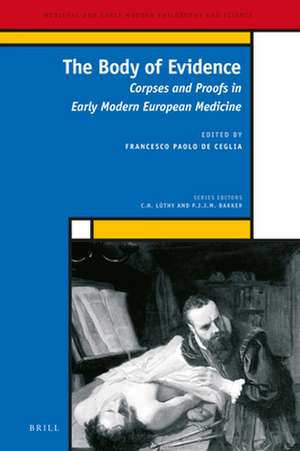The Body of Evidence: Corpses and Proofs in Early Modern European Medicine: Medieval and Early Modern Philosophy and Science, cartea 30
Contribuţii de A. W. Bates, Diego Carnevale, Lucia de Frenza, Tommaso Duranti, Carmel Ferragud, Massimo Galtarossa, Alexander Kästner, Margaret Brannan Lewis, R. Allen Shotwell, Kevin Siena, Caterina Tisci Francesco Paolo de Cegliaen Limba Engleză Hardback – 22 ian 2020
Din seria Medieval and Early Modern Philosophy and Science
- 5%
 Preț: 1424.85 lei
Preț: 1424.85 lei - 18%
 Preț: 1026.13 lei
Preț: 1026.13 lei - 18%
 Preț: 667.77 lei
Preț: 667.77 lei - 18%
 Preț: 550.18 lei
Preț: 550.18 lei - 18%
 Preț: 682.61 lei
Preț: 682.61 lei - 18%
 Preț: 892.77 lei
Preț: 892.77 lei - 18%
 Preț: 897.36 lei
Preț: 897.36 lei - 18%
 Preț: 660.82 lei
Preț: 660.82 lei - 18%
 Preț: 870.98 lei
Preț: 870.98 lei - 18%
 Preț: 636.55 lei
Preț: 636.55 lei - 18%
 Preț: 633.06 lei
Preț: 633.06 lei - 18%
 Preț: 664.40 lei
Preț: 664.40 lei - 18%
 Preț: 678.68 lei
Preț: 678.68 lei - 18%
 Preț: 869.83 lei
Preț: 869.83 lei - 18%
 Preț: 584.93 lei
Preț: 584.93 lei - 18%
 Preț: 765.49 lei
Preț: 765.49 lei - 18%
 Preț: 795.00 lei
Preț: 795.00 lei - 18%
 Preț: 671.40 lei
Preț: 671.40 lei - 18%
 Preț: 600.75 lei
Preț: 600.75 lei - 18%
 Preț: 804.36 lei
Preț: 804.36 lei - 18%
 Preț: 838.40 lei
Preț: 838.40 lei - 18%
 Preț: 752.05 lei
Preț: 752.05 lei - 18%
 Preț: 632.02 lei
Preț: 632.02 lei - 18%
 Preț: 656.43 lei
Preț: 656.43 lei - 18%
 Preț: 679.75 lei
Preț: 679.75 lei - 18%
 Preț: 683.66 lei
Preț: 683.66 lei - 18%
 Preț: 900.54 lei
Preț: 900.54 lei - 18%
 Preț: 719.00 lei
Preț: 719.00 lei - 18%
 Preț: 723.43 lei
Preț: 723.43 lei - 18%
 Preț: 716.19 lei
Preț: 716.19 lei
Preț: 852.67 lei
Preț vechi: 1039.85 lei
-18% Nou
Puncte Express: 1279
Preț estimativ în valută:
163.15€ • 170.36$ • 134.73£
163.15€ • 170.36$ • 134.73£
Carte indisponibilă temporar
Doresc să fiu notificat când acest titlu va fi disponibil:
Se trimite...
Preluare comenzi: 021 569.72.76
Specificații
ISBN-13: 9789004284814
ISBN-10: 9004284818
Dimensiuni: 155 x 235 mm
Greutate: 0 kg
Editura: Brill
Colecția Brill
Seria Medieval and Early Modern Philosophy and Science
ISBN-10: 9004284818
Dimensiuni: 155 x 235 mm
Greutate: 0 kg
Editura: Brill
Colecția Brill
Seria Medieval and Early Modern Philosophy and Science
Notă biografică
Francesco Paolo de Ceglia, Ph.D. (2001), is a Professor of History of Science at the University of Bari, where he directs the Interuniversity Research Center, Seminary of the History of Science. He has often been a fellow at the Max Planck Institute for the History of Science in Berlin. He has published monographs and articles on the relationship between the history of science and theology, including The Secret of Saint Januarius. Natural History of a Neapolitan Miracle (Einaudi, 2016).
Cuprins
List of Figures
Contributing Authors
Introduction: Corpses, Evidence and Medical Knowledge in the Late Middle Ages and the Early Modern Age
Francesco Paolo de Ceglia
SECTION 1. FROM DIVINATION TO AUTOPSY
1. Saving the Phenomenon: Why Corpses Bled in the Presence of their Murderer in Early Modern Science
Francesco Paolo de Ceglia
2. Unfamiliar Faces: The Identification of Corpses In Late Medieval Valencia
Carmel Ferragud
3. Reading the Corpse (Bologna, Mid 13th-Early 16thth Century)
Tommaso Duranti
SECTION 2. THE UNCERTAINTIES OF THE ANATOMICAL GAZE
4. Dissection Techniques, Forensics and Anatomy in the Sixteenth Century
Allen Shotwell
5. Monstrous Exegesis: Opening Up Double Monsters in Early Modern Europe
Alan W.H. Bates
6. Corpses, Contagion and Courage: Fear and the Inspection of Bodies in Seventeenth-Century London
Kevin Siena
7. Knowledge from and on Bodies and Resistance to Anatomical Discourse (Padua, 16th-18th Centuries)
Massimo Galtarossa
SECTION 3: CORPSES AND EVIDENCES
8. Reading Deeds, Lifestyles and Bodies: The Classification of Suicide in Early Modern Europe
Alexander Kästner
9. Corpses and Confessions: Forensic Investigation and Infanticide in Early Modern Germany
Margaret Brannan Lewis
10. Visum et Repertum: Medical Doctrine and Criminal Procedures in France and Naples (17th-18th Centuries)
Diego Carnevale
11. Frightening Whirlpools: Drowning in France in the Eighteenth Century
Lucia De Frenza and Caterina Tisci
Bibliography
Index
Contributing Authors
Introduction: Corpses, Evidence and Medical Knowledge in the Late Middle Ages and the Early Modern Age
Francesco Paolo de Ceglia
SECTION 1. FROM DIVINATION TO AUTOPSY
1. Saving the Phenomenon: Why Corpses Bled in the Presence of their Murderer in Early Modern Science
Francesco Paolo de Ceglia
2. Unfamiliar Faces: The Identification of Corpses In Late Medieval Valencia
Carmel Ferragud
3. Reading the Corpse (Bologna, Mid 13th-Early 16thth Century)
Tommaso Duranti
SECTION 2. THE UNCERTAINTIES OF THE ANATOMICAL GAZE
4. Dissection Techniques, Forensics and Anatomy in the Sixteenth Century
Allen Shotwell
5. Monstrous Exegesis: Opening Up Double Monsters in Early Modern Europe
Alan W.H. Bates
6. Corpses, Contagion and Courage: Fear and the Inspection of Bodies in Seventeenth-Century London
Kevin Siena
7. Knowledge from and on Bodies and Resistance to Anatomical Discourse (Padua, 16th-18th Centuries)
Massimo Galtarossa
SECTION 3: CORPSES AND EVIDENCES
8. Reading Deeds, Lifestyles and Bodies: The Classification of Suicide in Early Modern Europe
Alexander Kästner
9. Corpses and Confessions: Forensic Investigation and Infanticide in Early Modern Germany
Margaret Brannan Lewis
10. Visum et Repertum: Medical Doctrine and Criminal Procedures in France and Naples (17th-18th Centuries)
Diego Carnevale
11. Frightening Whirlpools: Drowning in France in the Eighteenth Century
Lucia De Frenza and Caterina Tisci
Bibliography
Index
